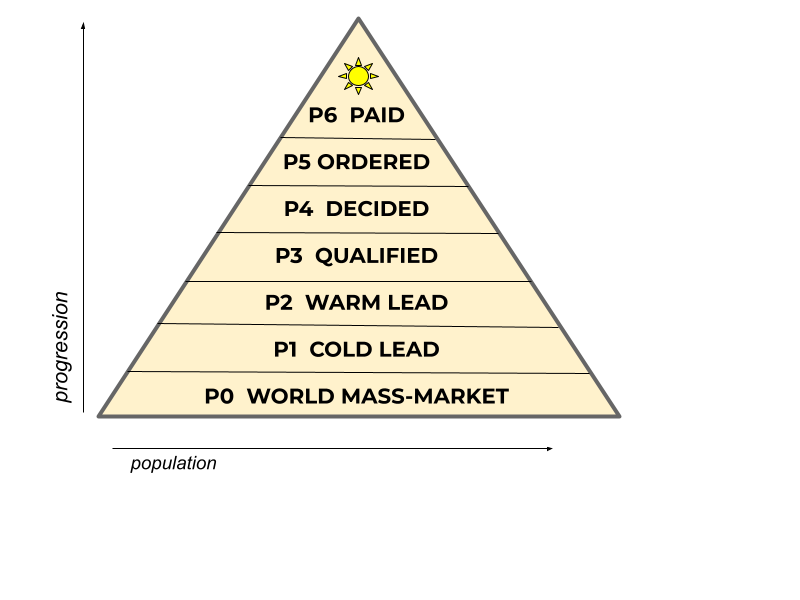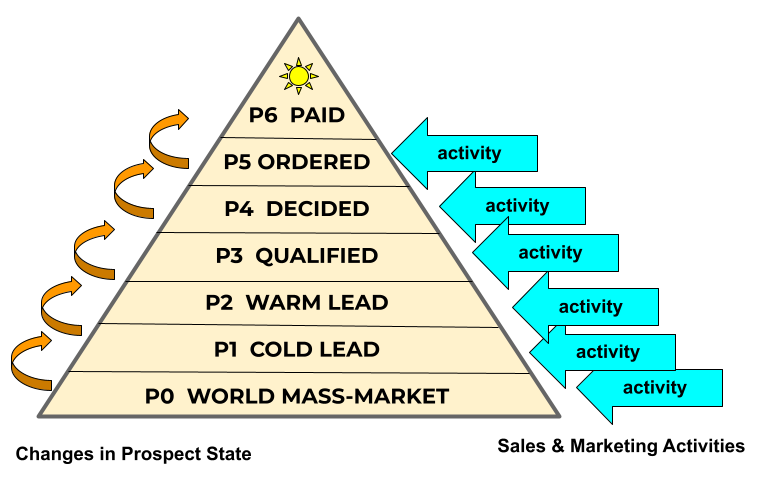Markets & Marketing - II
Minding your Ps & QCs...
Introducing Prospect Conversion Stages
We’ve covered the basics of Markets and of Sales in Parts 1 of each topic. Why this back-and-forth between Marketing and Sales? Because Marketing provides the command framework and Sales provides the execution framework.
In Sales & Selling-I, you encountered the Five Stages of the Buying Decision. This is a handy rule for salesmen to follow and basically reminds them of what to do next. It’s like telling a soldier how to use his rifle and tactical gear on the battlefield.
But that set of instructions is not useful at the command (management) level. What should we tell our troops to do? Where should we direct their efforts? How do we track and measure their progress against the strategy? What changes should we be making? Are we effectively using our resources?
But if there is a progression to the individual sales process is there also a corresponding progression to the entire sales effort akin to the entire battlefield? So that we can measure and map our progress as an organization? So that the various divisions can be tasked to logistically support the troops on the battlefield?
Yes, there is a corresponding progression. Understanding this will show us how to provide leadership to the entire sales effort and ensure that it takes place within the context of the strategic and the marketing plan.
I call it “The Prospect Conversion Pyramid,” ( Fig 1, below).
Many people have heard of a “Sales Funnel” which describes the stages that moves a Prospect to a paying Customer. But “The Prospect Conversion Pyramid,” gives us a better framework for management, organization, metrics, and reporting which allow our businesses to establish a framework which will be scalable1 and repeatable2.
Why are these concerns of import? Lacking them, and lacking the kind of metrics which we will discuss below, the only direction that Management can typically provide is: “Sell More!” And because the only results that most organizations measure is Revenue (“Sales”), Management lacks a granular means of evaluating the effectiveness of their strategy.
Why is that so? Because Sales Revenue is like the light from a distant star: It only tells you what happened in the PAST, not what is happening NOW. What is happening now, the playing out of the current strategy, is taking place at the LOWEST level of the Pyramid below. But if you only measure from the top of the pyramid, you will not be able to react swiftly to errors in the strategy. Like the light from a distant star which can take millions of years to reach earth, revenue only tells you how good your strategic execution was in the distant past.
The Basic P Levels
A prospect starts as an unknown faceless entity at the lowest level, P0, and – if all goes well – progresses to P6, a customer who has paid.
The width of the pyramid indicates the size of the population at each level. Since the width is decreasing, it means the expectation of the inevitable dropout from one level to the next of prospects who just do not progress or leave the scene entirely.
P0 is included for completeness. It consists of the entire world and is thus a mass market. It is within this pool that our mysterious market (See Markets & Marketing - I) exists.
Somehow, out of P0, will come our Leads3, which in this book means interested knowledge about one of the parties (Us or Them).
Interested Knowledge means knowing name and contact and having an interest in the product area. One-way knowledge is the P1 Cold Leads. Those having two-way knowledge are the P2s, Warm Leads.
At this point, we perform some type of qualification to determine if the Lead is a bonafide Prospect for our product. Some of these get Qualified and become P3s, at which point, traditional sales activities occur, resulting in a few which announce their Intention to buy, becoming P4s.
But not all P4s follow through with an actual order commitment (booking), and not all bookings become billings (shipped product) which are P5s – Ordered or Committed (contractually). Things happen such that not all receivables are able to be collected (product fails, is returned, buyers' remorse, etc).
The ones that do follow through with payment, become P6s: Paid Customers: Cash in the Bank. At this point, the prospect-to-customer process is complete4.
Deeper P Theory
But wait, there’s more.
Although we have somewhat described a basic marketing/sales funnel, there’s more going on with our Prospect Conversion Pyramid
The first, is that all eyes are on the prize: Cash in the Bank (P6). We want the organization focused on this; Not simply on orders or even receivables (which are just an IOU promise-someday-to-pay).
Real happy customers pay their bills. Until all of the cash is in the bank, the transaction is not finished. I learned about this the hard way at Motorola Japan with a million dollar receivable which had been delinquent for over a year.
The next point is how this Pyramid lends itself to a command/management paradigm.
Obviously, P progressions do not just happen on their own accord. The operation needs to do something to stimulate the conversions. That is nominally called marketing or sales activities. And from that activity, at some point, Prospects transition to the next level (a progression). Fig. 3-3 shows this. Later we'll dive deep into these kinds of activities. For right now, it's only important to understand that this must happen.
Reporting structures
We can task and direct various parts of the organization to be responsible for activities and conversions. We can set goals, we can make assumptions about percentage for progression to the next level. And most importantly we can get measurements for N (the size at the level), I (the progressions to the next level), and J (the amount of activity taking place). In this manner, management can track the effectiveness, daily or weekly, of types of activity and conversions taking place.
In short, it is a reporting structure.
Becoming Repeatable and Scalable
The Holy Grail of business, especially tech startups, is getting to the point where the business is repeatable and scalable.
When we have tuned the marketing message such that it resonates within our selected segments of our market, we see a spike in progressions from P1’s to P2’s and P2’s to P3’s. Until that point, we keep on experimenting with different messages and different approaches (activities) until we have justified our marketing assumptions.
No matter what the deployment method is – web site, online e-commerce, a juice stand at the side of the road, a long-lead sales team based activity – these principles hold true. I have seen situations where on a website, daily usage metrics were used to fine-tune the prospect’s progression through the site until the message matched the target profile and suddenly we got spikes in prospects progressing up the P chart.
The fine tuning was by changing color, size, and placement of action buttons, or a different desired flow of web pages, or changing graphics and marketing messages.
This means that the process has become repeatable and therefore scalable. The business now can grow.
Summary
I've introduced my view of the marketing/sales funnel, termed the Prospect Conversion Pyramid. I’ve shown how the operational organization should be aligned to match that structure. I’ve shown how there are tactical activities which need to occur at each level and corresponding conversion metrics which can be measured. I’ve shown that a startup business can use this to become repeatable and scalable. And I’ve oriented everything in this structure towards actual received revenue in the bank, the goal of the operational side of the business.
Business operations must be driven off of this process. Later in Sales & Selling - 3, we will uncover further secrets towards making this entire concept more powerful.
Making Use of this Information
I have a variety of Quick & Dirty Methods for building off of these basics and turning this framework into actionable and highly effective strategic plans. Ignite! Act! Win! Training and Business Coaching works closely with you to move your business forward to success.
The Mechanics of Business is an integrated approach, built off of a strong theoretical foundation of how business operations work to generate sales in any market.
In these articles I am showing you the insights which unlocked magic for me. Stay tuned to this Channel!
Contact me directly for getting hands-on Business Coaching to help you efficiently leverage this information in your business.
Scalable: The ability of a business to increase its output or revenue without a proportional increase in resources; eg: To Scale the business.
Repeatable: The ability of a process, product, or service to be replicated consistently with the same results.
Typically, ‘lead’ means somebody who has demonstrated interest in your offerings, such as by visiting your website, downloading content, attending an event, or making an inquiry. But the opposite could be true: if I’m selling high-end embedded computer technology parts, I might make a list of OEMs who produce semiconductor manufacturing equipment. This would be a list of potential leads and used in cold calling.
But, the sales process is not complete. The true measure of customer satisfaction/loyalty is if the customer orders again and makes a follow-on purchase.




